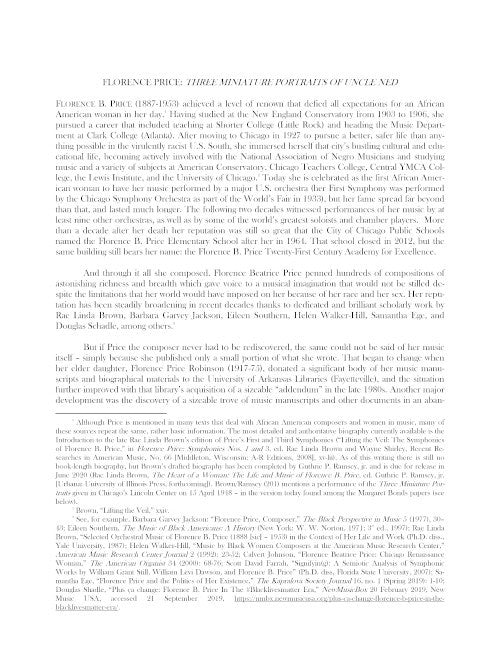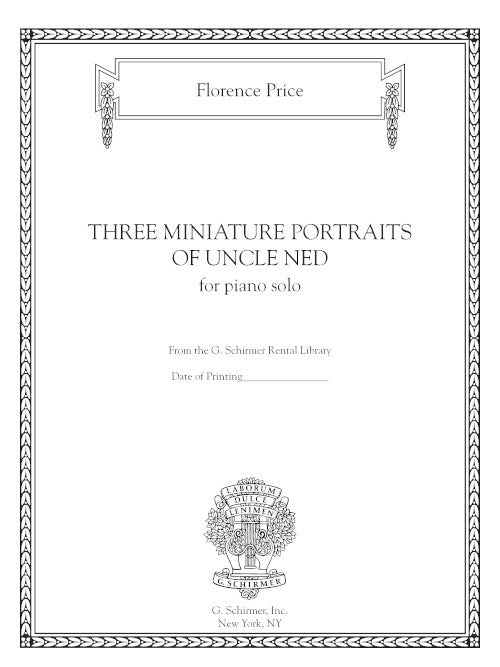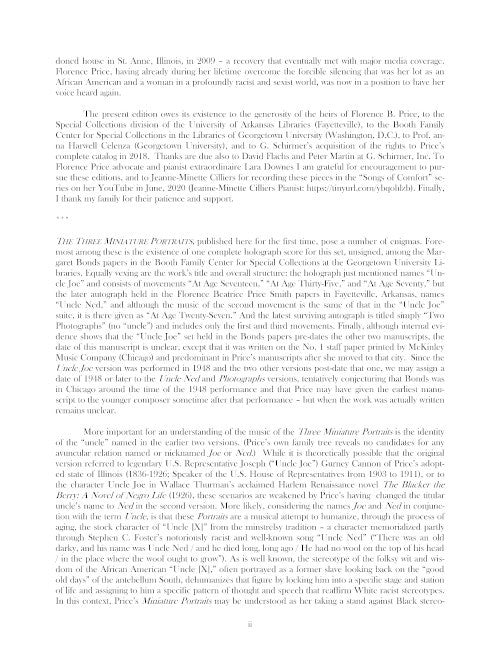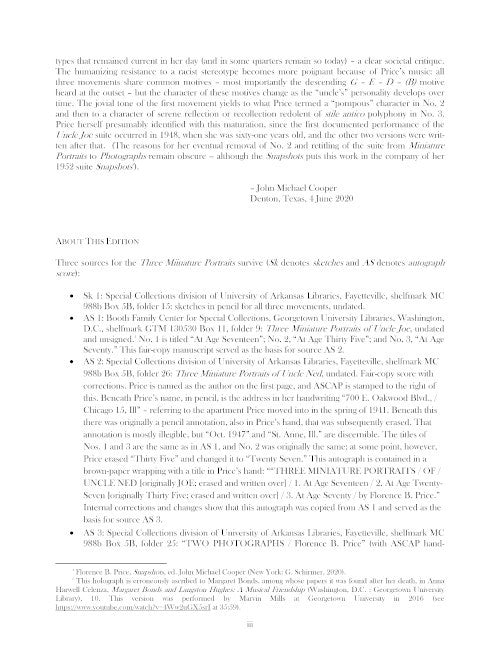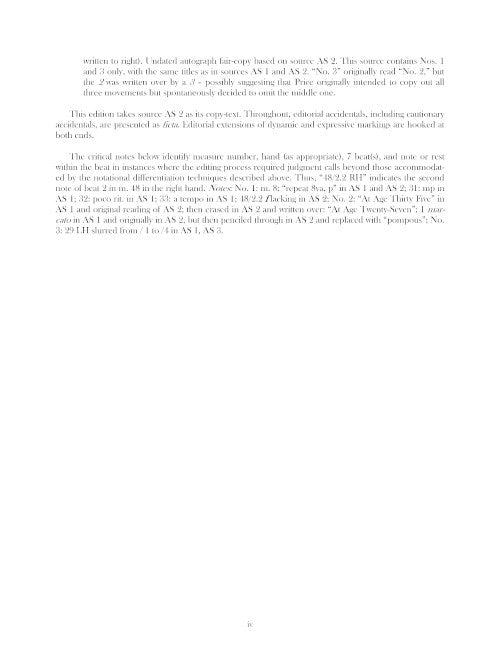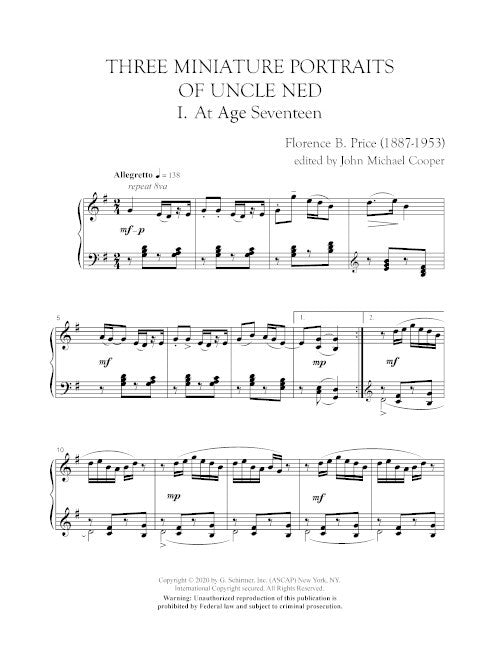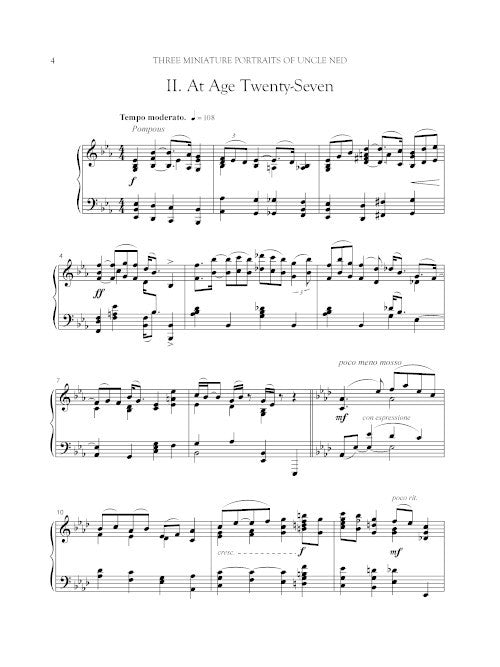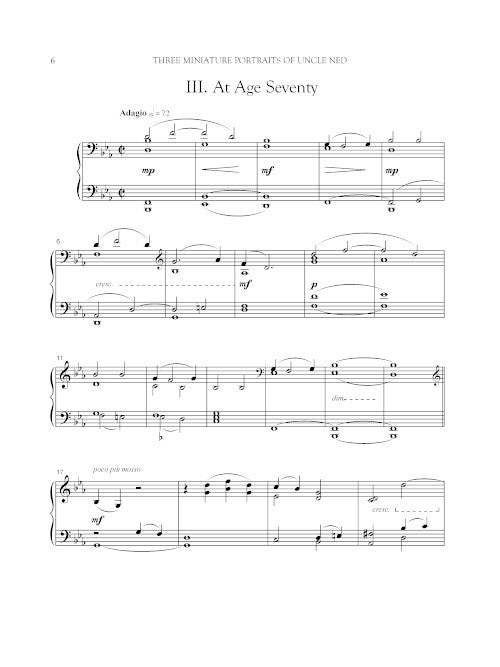Price: Three Miniature Portraits of Uncle Ned
This item is made to order and typically ships within 1-2 weeks.
- Composer: Florence Price (1887-1953)
- Instrumentation: Piano
- Work: Three Miniature Portraits of Uncle Ned
- Size: 8.9 x 12.0 inches
Description
Movements:
- I. At Age Seventeen
- II. At Age Twenty-Seven
- III. At Age Seventy
The Three Miniature Portraits , published here for the first time, pose a number of enigmas. Foremost among these is the existence of one complete holograph score for this set, unsigned, among the Margaret Bonds papers in the Booth Family Center for Special Collections at the Georgetown University Libraries. Equally vexing are the work's title and overall structure: the holograph just mentioned names "Uncle Joe" and consists of movements "At Age Seventeen," "At Age Thirty-Five," and "At Age Seventy," but the later autograph held in the Florence Beatrice Price Smith papers in Fayetteville, Arkansas, names "Uncle Ned," and although the music of the second movement is the same of that in the "Uncle Joe" suite, it is there given as "At Age Twenty-Seven." and the latest surviving autograph is titled simply "Two Photographs" (no "uncle") and includes only the first and third movements. Finally, although internal evidence shows that the "Uncle Joe" set held in the Bonds papers pre-dates the other two manuscripts, the date of this manuscript is unclear, except that it was written on the No. 1 staff paper printed by McKinley Music Company (Chicago) and predominant in Price's manuscripts after she moved to that city. Since the Uncle Joe version was performed in 1948 and the two other versions post-date that one, we may assign a date of 1948 or later to the Uncle Ned and Photographs versions, tentatively conjecturing that Bonds was in Chicago around the time of the 1948 performance and that Price may have given the earliest manuscript to the younger composer sometime after that performance — but when the work was actually written remains unclear.
More important for an understanding of the music of the Three Miniature Portraits is the identity of the "uncle" named in the earlier two versions. (Price's own family tree reveals no candidates for any avuncular relation named or nicknamed Joe or Ned.) While it is theoretically possible that the original version referred to legendary U.S. Representative Joseph ("Uncle Joe") Gurney Cannon of Price's adopted state of Illinois (1836-1926; Speaker of the U.S. House of Representatives from 1903 to 1911), or to the character Uncle Joe in Wallace Thurman's acclaimed Harlem Renaissance novel The Blacker the Berry: A Novel of Negro Life (1926), these scenarios are weakened by Price's having changed the titular uncle's name to Ned in the second version. More likely, considering the names Joe and Ned in conjunction with the term Uncle , is that these Portraits are a musical attempt to humanize, through the process of aging, the stock character of "Uncle [X]" from the minstrelsy tradition — a character memorialized partly through Stephen C. Foster's notoriously racist and well-known song "Uncle Ned" ("There was an old darky, and his name was Uncle Ned / and he died long, long ago / He had no wool on the top of his head / in the place where the wool ought to grow"). As is well known, the stereotype of the folksy wit and wisdom of the African American "Uncle [X]," often portrayed as a former slave looking back on the "good old days" of the antebellum South, dehumanizes that figure by locking him into a specific stage and station of life and assigning to him a specific pattern of thought and speech that reaffirm White racist stereotypes. in this context, Price's Miniature Portraits may be understood as her taking a stand against Black stereotypes that remained current in her day (and in some quarters remain so today) — a clear societal critique. The humanizing resistance to a racist stereotype becomes more poignant because of Price's music: all three movements share common motives — most importantly the descending G – E – D – (B) motive heard at the outset — but the character of these motives change as the "uncle's" personality develops over time. The jovial tone of the first movement yields to what Price termed a "pompous" character in No. 2 and then to a character of serene reflection or recollection redolent of stile antico polyphony in No. 3. Price herself presumably identified with this maturation, since the first documented performance of the Uncle Joe suite occurred in 1948, when she was sixty-one years old, and the other two versions were written after that. (The reasons for her eventual removal of No. 2 and re-titling of the suite from Miniature Portraits to Photographs remain obscure — although the Snapshots puts this work in the company of her 1952 suite Snapshots).
— John Michael Cooper
Publishers use a lot of words to describe what they sell, and we know it can be confusing. We've tried to be as clear as possible to make sure you get exactly what you are looking for. Below are descriptions of the terms that we use to describe the various formats that music often comes in.
Choral Score
A score for vocalists that only contains the vocal lines. The instrumental parts are not there for reference. Generally, cheaper than a vocal score and requires multiple copies for purchase.
Facsimile
Reproductions of the original hand-written scores from the composer.
Full Score
For ensemble music, this indicates that the edition contains all parts on a single system (there are not separate parts for each player). In larger ensembles, this is for the conductor.
Hardcover
Hardbound. Generally either linen-covered or half-leather.
Orchestral Parts
Similar to a wind set, this is a collection of parts. In the case of strings, the numbers listed are the number of copies included, though generally these are available individually (often with minimum quantities required).
Paperback
When publishers offer multiple bindings (e.g. hardcover) or study scores, this is the "standard" version. If you're planning to play the music, this is probably what you want.
Performance / Playing Score
A score of the music containing all parts on one system, intended for players to share. There are not separate parts for each player.
Set of Parts
For ensemble music, this indicates that there are separate individual parts for each player.
Solo Part with Piano Reduction
For solo pieces with orchestra, this is a version that contains a piano reduction of the orchestra parts. For piano pieces, two copies are typically needed for performance.
Study Score
A small (think choral size) copy of the complete score meant for studying, and not playing. They make great add-ons when learning concertos and small chamber works.
Vocal Score
A score prepared for vocalists that includes the piano/organ part or a reduction of the instrumental parts.
Wind Set
For orchestral music, this is a collection of wind and percussion parts. The specific quantities of each instrument are notated.
With Audio
In addition to the printed music, the edition contains recordings of the pieces. This may be an included CD, or access to files on the internet.
With / Without Fingering (Markings)
Some publishers prepare two copies - a pure Urtext edition that includes no fingering (or bowing) suggestions and a lightly edited version that includes a minimal number of editorial markings.
